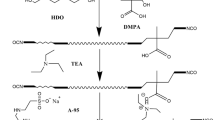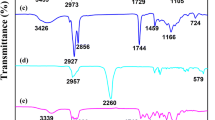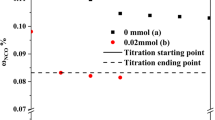Abstract
Waterborne polyurethane (WPU) with high solid content (50–60%wt) was synthesized by using mixed polyester diol with the different crystalline degree. The crystallinity of the soft segment was controlled by changing the ratio of polyester polyols. The stability and the particle size of the emulsion were analyzed in detail. The mechanical properties, thermal properties, and water absorption of the emulsion film were also investigated. The degree of crystallization of the soft segment had an essential influence on the performance of the emulsion and the film, and the optimal ratio of the soft segment by the control of crystallinity was obtained. Furthermore, alcohol hydroxy silicone oil was used to modify the WPU. The results showed that the introduction of a silicone chain segment could improve the thermal stability and water resistance of the material. The optimal amount of silicone oil was confirmed by adjusting the amount of silicone oil (4%wt).













Similar content being viewed by others
References
Bian Y, Ho TT, Kwon Y, Kim JS (2018) Thermal and mechanical characterization of polymeric foams with controlled porosity using hollow thermoplastic spheres. J Nanosci Nanotechnol 18:936–942. https://doi.org/10.1166/jnn.2018.14912
Zhang L, Jiang Y, Xiong Z, Liu X, Na H, Zhang R, Zhu J (2013) Highly recoverable rosin-based shape memory polyurethanes. J Mater Chem A 1. https://doi.org/10.1039/c3ta01655b
Fang Y, Li J, Du X, Du Z, Cheng X, Wang H (2018) Thermal- and mechanical-responsive polyurethane elastomers with self-healing, mechanical-reinforced, and thermal-stable capabilities. Polymer 158:166–175. https://doi.org/10.1016/j.polymer.2018.10.056
Hashemi Nasr F, Barikani M, Salehirad M (2018) Preparation of self-healing polyurethane/functionalized graphene nanocomposites as electro-conductive one part adhesives. RSC Adv 8:31094–31105. https://doi.org/10.1039/C8RA03685C
Wang J-P, Song X, Wang J-K, Cui X, Zhou Q, Qi T, Li GL (2019) Smart-sensing polymer coatings with autonomously reporting corrosion dynamics of self-healing systems. Adv Mater Interfaces 6:1900055. https://doi.org/10.1002/admi.201900055
Kupka V, Benesova P, Obruca S, Brtnikova J, Marova I, Jancar J, Vojtova L (2019) Biodegradation of polyurethane-polyhydroxybutyrate elastomeric composite investigated from morphological and structural viewpoint. J Appl Polym Sci 136:46909. https://doi.org/10.1002/app.46909
Yu CL, Yan CF, Shao JT, Zhang F (2021) Preparation and properties of rosin-based cationic waterborne polyurethane dispersion. Colloid Polym Sci 299:1489. https://doi.org/10.1007/s00396-021-04872-z
Vadillo J, Larraza I, Calvo-Correas T, Gabilondo N, Derail C, Eceiza A (2021) Design of a waterborne polyurethane-urea ink for direct ink writing 3D printing. Materials 14:13. https://doi.org/10.3390/ma14123287
Agnol LD, Dias FTG, Ornaghi HL, Sangermano M, Bianchi O (2021) UV-curable waterborne polyurethane coatings: a state-of-the-art and recent advances review. Prog Org Coat 154:20. https://doi.org/10.1016/j.porgcoat.2021.106156
Diao S, Zhang YQ, Zhao CD, Wang MY, Yu JC (2022) Preparation of waterborne polyurethane based on different polyols: the effect of structure and crystallinity. J Polym Res 29:105. https://doi.org/10.1007/s10965-022-02960-4
Park SH, Chung ID, Hartwig A, Kim BK (2007) Hydrolytic stability and physical properties of waterborne polyurethane based on hydrolytically stable polyol. Colloids Surf A Physicochem Eng Asp 305:126–131. https://doi.org/10.1016/j.colsurfa.2007.04.051
Morsi SMM, Mohamed HA (2017) A comparative study of new linear and hyperbranched polyurethanes built up from a synthesized isocyanate-terminated polyester/urethane. Polym Bull 74:5011–5027. https://doi.org/10.1007/s00289-017-1996-0
Mohamed HA, Badran BM, Rabie AM, Morsi SMM (2014) Synthesis and characterization of aqueous (polyurethane/aromatic polyamide sulfone) copolymer dispersions from castor oil. Prog Org Coat 77:965–974. https://doi.org/10.1016/j.porgcoat.2014.01.026
Athawale VD, Nimbalkar RV (2010) Emulsifyable air drying urethane alkyds. Prog Org Coat 67:66–71. https://doi.org/10.1016/j.porgcoat.2009.09.017
Cao GH, Xia ZB, Lei L, Zhang YH, Xing JH (2014) Crystallinity evolution of soft segments during the synthesis of polyester- based waterborne polyurethane. J Appl Polym Sci 131:9. https://doi.org/10.1002/app.40270
Hou JH, Ma YF, Zhang ZH, Yang XH, Huang MH, Chai CP (2019) The relationship between solid content and particle size ratio of waterborne polyurethane. Coatings 9:9. https://doi.org/10.3390/coatings9060401
Song N, Xin XL, Liu HQ, Xu BC, Li B, Li YY, Hou SS, Yu Y (2019) Effects of different macrodiols as soft segments on properties of waterborne polyurethane. J Polym Res 26:11. https://doi.org/10.1007/s10965-019-1793-6
Liu YU, Liang HQ, Li SH, Liu D, Long YJ, Liang GD, Zhu FM (2019) Preparation of waterborne polyurethane with high solid content and elasticity. J Polym Res 26:8. https://doi.org/10.1007/s10965-019-1795-4
Furtado CA, de Souza PP, Goulart Silva G, Matencio T, Pernaut JM (2001) Electrochemical behavior of polyurethane ether electrolytes/carbon black composites and application to double layer capacitor. Electrochim Acta 46:1629–1634. https://doi.org/10.1016/S0013-4686(00)00763-5
Peng S, Jin Y, Sun T, Qi R, Fan B, Cheng X (2014) Synthesis of high solid content waterborne polyurethanes with controllable bimodal particle size distribution. J Appl Polym Sci. https://doi.org/10.1002/app.40420
Peng S-J, Jin Y, Cheng X-F, Sun T-B, Qi R, Fan B-Z (2015) A new method to synthesize high solid content waterborne polyurethanes by strict control of bimodal particle size distribution. Prog Org Coat 86:1–10. https://doi.org/10.1016/j.porgcoat.2015.03.013
Chai C-P, Ma Y-F, Li G-P, Ge Z, Ma S-Y, Luo Y-J (2018) The preparation of high solid content waterborne polyurethane by special physical blending. Prog Org Coat 115:79–85. https://doi.org/10.1016/j.porgcoat.2017.10.021
Wang X-M, Li Q (2019) A new method for preparing low viscosity and high solid content waterborne polyurethane—phase inversion research. Prog Org Coat 131:285–290. https://doi.org/10.1016/j.porgcoat.2019.02.001
Kloss J, Munaro M, De Souza GP, Gulmine JV, Wang SH, Zawadzki S, Akcelrud L (2002) Poly(ester urethane)s with polycaprolactone soft segments: a morphological study. J Polym Sci Part A Polym Chem 40:4117–4130. https://doi.org/10.1002/pola.10499
García-Pacios V, Colera M, Iwata Y, Martín-Martínez JM (2013) Incidence of the polyol nature in waterborne polyurethane dispersions on their performance as coatings on stainless steel. Prog Org Coat 76:1726–1729. https://doi.org/10.1016/j.porgcoat.2013.05.007
Liu N, Zhao Y, Kang M, Wang J, Wang X, Feng Y, Yin N, Li Q (2015) The effects of the molecular weight and structure of polycarbonatediols on the properties of waterborne polyurethanes. Prog Org Coat 82:46–56. https://doi.org/10.1016/j.porgcoat.2015.01.015
Fan X, Zhang Z, Yue S, Xiao C (2017) Fabrication, characterization and properties of waterborne polyurethane/3-aminopropyltriethoxysilane/multiwalled carbon nanotube nanocomposites via copolycondensation of hydroxyls. Polym Bull 74:2719–2739. https://doi.org/10.1007/s00289-016-1859-0
Wu Y, Guo P, Zhao Y, Liu X, Du Z (2019) Hydrophobic, transparent waterborne polyurethane-polydimethylsiloxane composites prepared from aqueous sol-gel process and applied in corrosion protection. Prog Org Coat 127:231–238. https://doi.org/10.1016/j.porgcoat.2018.06.002
Liu T, Liu D, Zhou W, Ni L, Quan H, Yang Z (2018) Effects of soft segment and microstructure of polysiloxane modified cationic waterborne polyurethane on the properties of its emulsion and membrane. Mater Res Express 6:025304
Acknowledgements
Financial support from the National Natural Science Foundation of China (NSFC, No. 51603178) is gratefully acknowledged. Supported by Foundation of Key Laboratory of Special Functional Aggregated Materials, Ministry of Education, P.R. China
Author information
Authors and Affiliations
Corresponding author
Ethics declarations
Conflict of interest
We declare that we have no financial and personal relationships with other people or organizations that can inappropriately influence our work, there is no professional or other personal interest of any nature or kind in any product, service and/or company that could be construed as influencing the position presented in, or the review of, the manuscript entitled.
Additional information
Publisher's Note
Springer Nature remains neutral with regard to jurisdictional claims in published maps and institutional affiliations.
Rights and permissions
Springer Nature or its licensor (e.g. a society or other partner) holds exclusive rights to this article under a publishing agreement with the author(s) or other rightsholder(s); author self-archiving of the accepted manuscript version of this article is solely governed by the terms of such publishing agreement and applicable law.
About this article
Cite this article
Diao, S., Zhang, Y., Zhao, C. et al. Preparation of waterborne polyurethane with high solid content: the crystallinity control of soft segment and the organosilicon modification. Polym. Bull. 81, 317–333 (2024). https://doi.org/10.1007/s00289-023-04718-4
Received:
Revised:
Accepted:
Published:
Issue Date:
DOI: https://doi.org/10.1007/s00289-023-04718-4




